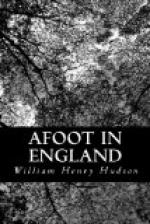It will be said that the facts of Bloomfield’s life—that he was a farmer’s boy whose daily tasks were to scare the crows, feed the pigs, and forty things besides, and that later, when learning the shoemaker’s trade in a London garret, he put these memories together and made them into a poem—are wholly beside the question when we come to judge the work as literature. A peasant poet may win a great reputation in his own day on account of the circumstances of the case, but in the end his work must be tried by the same standards applied in other and in all cases.
There is no getting away from this, and all that remains is to endeavour to show that the poem, although poor as a whole, is not altogether bad, but contains many lines that glow with beautiful poetic feeling, and many descriptive passages which are admirable. Furthermore, I will venture to say that despite the feebleness of a large part of the work (as poetry) it is yet worth preserving in its entirety on account of its unique character. It may be that I am the only person in England able to appreciate it so fully owing to the way in which it first came to my notice, and the critical reader can, if he thinks proper, discount what I am now saying as mere personal feeling. But the case is this: when, in a distant region of the world, I sought for and eagerly read anything I could find relating to country scenes and life in England —the land of my desire—I was never able to get an extended and congruous view of it, with a sense of the continuity in human and animal life in its relation to nature. It was all broken up into pieces or “bits”; it was in detached scenes, vividly reproduced to the inner eye in many cases, but unrelated and unharmonized, like framed pictures of rural subjects hanging on the walls of a room. Even the Seasons failed to supply this want, since Thomson in his great work is of no place and abides nowhere, but ranges on eagle’s wings over the entire land, and, for the matter of that, over the whole globe. But I did get it in the Farmer’s Boy. I visualized the whole scene, the entire harmonious life; I was with him from morn till eve always in that same green country




